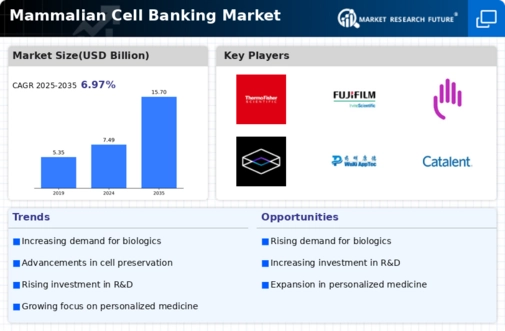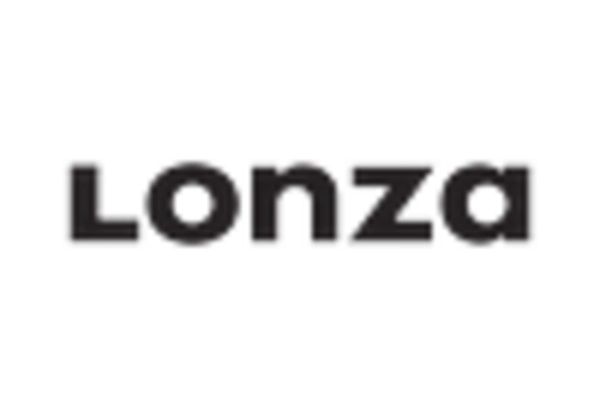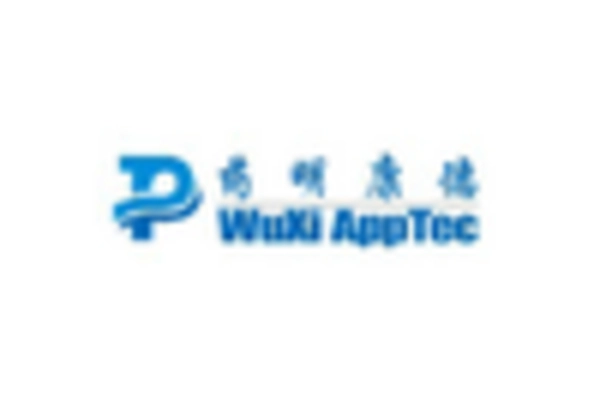Rising Demand for Biopharmaceuticals
The increasing demand for biopharmaceuticals is a primary driver of the Mammalian Cell Banking Market. As the healthcare sector continues to evolve, there is a notable shift towards biologics, which are derived from living organisms. This trend is evidenced by the fact that biopharmaceuticals accounted for approximately 25% of the total pharmaceutical market in recent years. The need for mammalian cell lines, which are essential for the production of these biologics, is thus expected to rise. Furthermore, the growing prevalence of chronic diseases necessitates the development of innovative therapies, further propelling the demand for mammalian cell banking solutions. As a result, companies are increasingly investing in the establishment of robust cell banks to ensure a steady supply of high-quality cells for research and production purposes.
Growing Focus on Personalized Medicine
The shift towards personalized medicine is emerging as a significant driver for the Mammalian Cell Banking Market. As healthcare becomes more tailored to individual patient needs, the demand for specific cell lines that can be used in personalized therapies is increasing. This trend is reflected in the growing number of clinical trials focused on personalized treatments, which have seen a rise of over 30% in recent years. Mammalian cell banks play a crucial role in this paradigm shift, as they provide the necessary cell lines for the development of customized therapies. Furthermore, the ability to create patient-specific cell lines enhances the efficacy of treatments, thereby driving the need for advanced cell banking solutions. As personalized medicine continues to gain traction, the mammalian cell banking market is likely to experience substantial growth, driven by the demand for tailored therapeutic options.
Increasing Investment in Biotechnology
The surge in investment within the biotechnology sector is a crucial driver for the Mammalian Cell Banking Market. Venture capital funding and government grants have been on the rise, with biotechnology companies receiving substantial financial backing to develop new therapies and products. In recent years, investments in biotechnology have reached unprecedented levels, with estimates suggesting that the sector attracted over 50 billion dollars in funding. This influx of capital is facilitating the establishment of new mammalian cell banks, which are essential for the production of biologics and other therapeutic agents. Moreover, as more startups emerge in the biotechnology space, the demand for reliable cell banking solutions is expected to grow, further propelling the market forward. The increasing focus on research and development in biotechnology is likely to create a favorable environment for the mammalian cell banking industry.
Advancements in Cell Culture Technologies
Technological innovations in cell culture methodologies are significantly influencing the Mammalian Cell Banking Market. The introduction of advanced bioreactors and automated systems has enhanced the efficiency and scalability of cell culture processes. For instance, the use of perfusion systems allows for continuous cell culture, which can lead to higher yields of desired products. Additionally, the integration of artificial intelligence and machine learning in cell culture optimization is becoming more prevalent, enabling researchers to achieve better results with less trial and error. These advancements not only improve the quality of mammalian cell banks but also reduce production costs, making it more feasible for companies to invest in cell banking solutions. As a result, the market is likely to witness a surge in demand for innovative cell culture technologies that support the growth of the mammalian cell banking sector.
Regulatory Support for Cell-Based Therapies
Regulatory bodies are increasingly recognizing the importance of cell-based therapies, which is positively impacting the Mammalian Cell Banking Market. The establishment of clear guidelines and frameworks for the development and commercialization of cell-based products is fostering innovation in this field. Regulatory agencies are working to streamline the approval processes for cell therapies, which encourages companies to invest in mammalian cell banking solutions. For instance, the introduction of expedited pathways for regenerative medicine products has made it easier for developers to bring their therapies to market. This supportive regulatory environment is likely to enhance the demand for mammalian cell banks, as companies seek to ensure compliance with stringent quality standards. As the landscape of cell-based therapies continues to evolve, the mammalian cell banking market is expected to benefit from these regulatory advancements.


















Leave a Comment